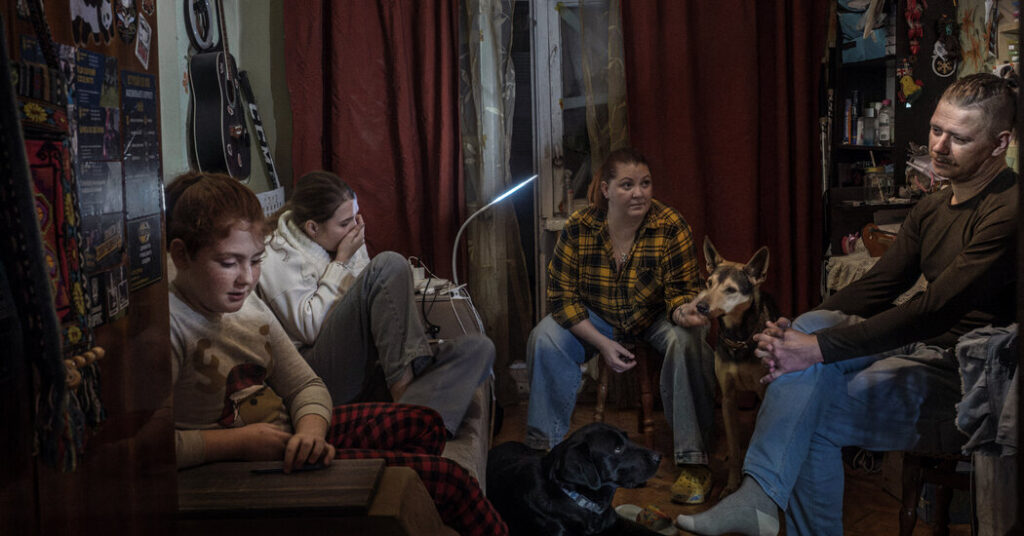Three winters of Russian strikes on Ukraine’s power grid have taught Oleksandra Kovalenko and her family how to live in the dark. When the lights go out, they turn to power banks, and the children do their homework by headlamp. If blackouts drag on, they head to a mall to recharge devices.
“Everyone has more or less adapted,” Ms. Kovalenko, 37, said.
What made those wartime winters bearable, she added, was the steady flow of gas that kept the stove burning and the radiators warm in her three-room apartment on Kyiv’s northern edge, where she lives with her mother, husband and two children.
But as a fourth winter looms, Russia has expanded its attacks from Ukraine’s power grid to its gas infrastructure, hitting wells, storage sites, pipelines and other critical components. The Kovalenkos are wondering if they are about to lose a lifeline that has carried them through the war’s coldest months.
“If we can somehow live without electricity, then living without gas — I’m afraid to even picture it,” Ms. Kovalenko said. “I don’t want to.”
It is a nightmare scenario that officials say is Russia’s latest bid to destroy Ukrainians’ resilience after years of deadly strikes on residential areas and relentless attacks on power plants that have plunged millions into darkness and forced businesses to cut production.
In recent weeks, officials have warned that Ukraine may be heading into its harshest winter since the full-scale invasion in February 2022. Gas is the source of heat and cooking fuel for 80 percent of households in Ukraine, according to Sergii Koretskiy, chief executive of Naftogaz, the country’s state-owned gas giant. Most apartment blocks rely on centralized heating systems powered by gas.
For the first three years of the war, Moscow mostly avoided striking Ukraine’s gas network because it was used to transport Russian gas to Europe. But on Jan. 1, Russian gas stopped flowing through Ukraine as Kyiv ended a transit deal.
Soon after, Russia turned its fire on Ukraine’s gas facilities. In February and March, drones and missiles wiped out about 40 percent of Ukrainian gas production capacity, Mr. Koretskiy said in an interview.
Because the strikes came near the end of the months when Ukrainians use most heat, usually late October to early April, the immediate impact was limited, Mr. Koretskiy said. Naftogaz spent the summer repairing infrastructure and, by September, had largely restored its production capacity.
But in October, Russia renewed its assaults, hitting even more ferociously. Naftogaz’s facilities were struck seven times last month in attacks that knocked out 60 percent of production capacity, according to a European official who spoke on the condition of anonymity to discuss a sensitive issue.
Some cities have faced temporary gas shortages, and experts warn that if the assaults continue, millions could struggle to keep their homes warm. Turning to electric heaters is not an option, because that would only deepen the strain on Ukraine’s battered power grid. Recent attacks have led to hourslong power cuts.
There is now growing fear that where Russia failed to break Ukraine by plunging it into darkness, it may yet succeed by plunging it into cold.
Mr. Koretskyi said that Naftogaz was racing to import several billion cubic meters of gas to make it through the winter. In a sign of the urgency, President Volodymyr Zelensky has called European leaders to secure gas supplies and funding while his government explores possible purchases of American liquefied natural gas.
The gas system is not a difficult target for Moscow. Ihor Klymenko, Ukraine’s interior minister, said in an interview this summer that “the Russians know perfectly well” where the country’s gas infrastructure is and how it was built, because it dates to Soviet times.
Russia has struck plants that produce both electricity and heat. Known as cogeneration facilities, some run on gas.
Tetyana Viter, 40, a resident of Kyiv, said she was jolted out of her bed in late October when a Russian missile hit a cogeneration facility visible from her bedroom window. “I came to the window and thought, ‘What is that?” she recounted. “And then, just a second later — a strike. I turn my head, and there’s already a fire.” Her neighborhood soon faced electricity shortages.
Ms. Viter, a florist, fled Ukraine in the first year of the war and returned a year ago. Anticipating power outages, she rented an apartment with gas-powered heating and a gas stove. Most buildings in her neighborhood rely on gas, as shown by the thin yellow pipes crisscrossing their facades.
“At that time, I thought it was the best decision, specifically because of the gas,” she said. “Back then, there were no problems with gas at all, only electricity.”
But what Ms. Viter once saw as a lifeline may soon turn into a liability for Ukraine. Andrii Zhupanyn, chairman of the Ukrainian Parliament’s subcommittee on natural gas policy, said, “There’s no quick alternative to provide heating” from gas, posing serious problems for large cities relying on centralized heating systems.
The situation has left the Kovalenko family scratching their heads. On a recent evening, they huddled in their tiny living room, debating what to do if the gas ran out. Should they buy gas canisters for cooking, coal for barbecues or wet wipes in case hot water disappears?
As has become customary among Ukrainians facing yet more hardship, they confronted the latest challenge with a sense of wry humor.
“I have friends who go camping. They’ve told me all about it,” said Ms. Kovalenko’s daughter, Yelyzaveta, 16.
“You mean, like, we’ll have to prepare to live as if we’re camping?” her mother asked.
“Well, maybe,” Yelyzaveta said.
“So what? Cool!” her father, Oleksandr Kovalenko, chimed in. “Grill on the balcony!”
To counter the threat of gas shortages, Naftogaz is ramping up imports to offset production losses. In the first half of 2025, gas imports increased 19 times compared with the same period in 2024, according to the Ukrainian energy think tank DiXi Group.
Mr. Koretskyi, the head of Naftogaz, said that Ukraine now needed to import 4.4 billion cubic meters of gas to make it through the winter, at a cost of about $2 billion. Naftogaz has secured nearly three-quarters of the funding from Europe and from Ukrainian government grants and loans from Ukrainian banks, Mr. Koretskyi noted, but more gas is likely to be needed if attacks persist.
Once imported gas arrives, it is stored in underground facilities too deep to be hit by drones and missiles. Mr. Koretskyi said that about 13 billion cubic meters were already stored, enough to cover much of the country’s winter needs.
But Russia has struck compressor stations that pump the gas from underground, as well as the pipelines that distribute it nationwide, raising fears that Ukraine may not be able to use all the gas it has stored.
Mr. Koretskyi urged Ukrainians to use gas more sparingly. “Every cubic meter matters,” he said. Much centralized heating in Ukraine is Soviet-era and typically warms apartments to about 75 degrees Fahrenheit, or nearly 24 degrees Celsius, unusually high by European standards.
For now, the radiators in the Kovalenkos’ apartment are humming with heat. If all she had to worry about were herself and her husband, Ms. Kovalenko said, she wouldn’t fret about how long the gas will last. But the thought of her children suffering in the freezing cold terrifies her.
“It’s really frightening,” she said, “because you understand you’re responsible not just for yourself, but for your family.”
Constant Méheut reports on the war in Ukraine, including battlefield developments, attacks on civilian centers and how the war is affecting its people.
The post Russia Tried to Cut Ukraine’s Lights. Now It’s Aiming for the Heat. appeared first on New York Times.




